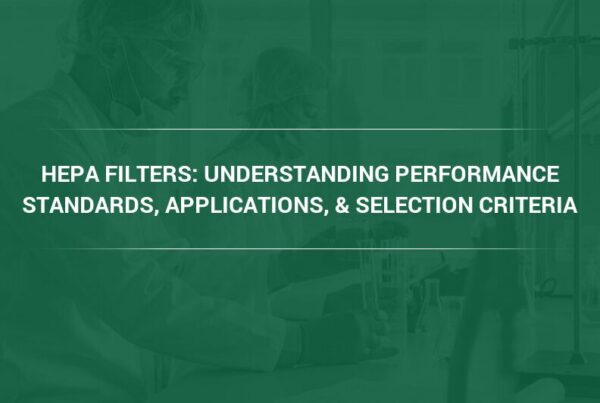Learn how and why home air filters may hold the key to reducing the risk of glaucoma, which a recent study ties to poor outdoor and indoor air quality.
According to a recent study, people who have a genetic history of glaucoma face a greater risk of developing vision loss after exposure to small-particle air pollution known as carbon black—more commonly known as soot.
Researchers discovered that among older men who bore the genetic characteristics common in individuals who are predisposed to oxidative stress, long-term exposure to carbon black increased their risk of feeling higher pressure in their eyes—a condition known as glaucoma, which can lead to blindness if left untreated. Carbon black is a dangerous airborne pollutant typically generated by vehicle emissions and the burning of fossil fuels.
The findings of the study, which were published in the journal JAMA Ophthalmology, helped shed light on a new dimension that eye doctors may not have considered before now. According to Jamaji Nwanaji-Enwerem, the study’s lead author and an MD/Ph.D. candidate at the Harvard Medical School, glaucoma is often linked to risk factors such as age and genetic predisposition, for example someone else in the family having glaucoma. In recent years, however, scientists are beginning to appreciate how the environment also affects vision health.
Impact of Outdoor and Indoor Air Quality on Eye Health
Nwanaji-Enwerem explains that one area in eye health that needs more research is how the environment affects a person’s risk of developing eye diseases. As such, he and his colleagues decided to look at the effect of outdoor and indoor air quality—more specifically, his research team analyzed the health impacts of tiny carbon black particles smaller than 2.5. microns in diameter.
While there is an established body of literature showing that these fine particles, known as PM2.5 or particulate matter that measures 2.5 microns in diameter, can induce respiratory and cardiovascular disease, not much is known about its effects on the body’s other organs.
Where Home Air Purifiers Are Beneficial
What is known, however, is that PM2.5 can enter the bloodstream, which is probably how toxic pollutants end up in the body’s different organ systems. In any case, the consensus among health and air quality experts is that particulate matter (PM) poses the greatest risk to human health, hence the importance of home air purifiers in any household.
“Below PM2.5, particles are more harmful because they are able to penetrate deeper into the lung alveoli,” explains Camfil USA’s Charlie Seyffer, Manager of Marketing & Technical Materials for commercial air filters and 37-year ASHRAE member and active committee participant. “They cross blood vessels walls, diffuse into the blood circulation, and are able to reach and affect organ function.”
The researchers pored through data from 419 older males in Boston who had signed up for a U.S. Department of Veterans Affairs aging study since the 1960s. As agreed upon, the men would come in for routine medical exams every three to five years. Part of these exams were measurements of their intraocular pressure.
For the study, Nwanaji-Enwerem’s team identified the level of air pollution the men were exposed to by using a modeling program that drew carbon black data from more than 80 monitoring stations and weather data.
Home Air Purification Systems and Oxidative Stress
Left untreated, glaucoma can eventually lead to blindness. But if caught early, the progressive loss of vision can be stopped. The key to doing this is to monitor intraocular pressure or fluid pressure inside the eye. While the researchers found no direct links between air pollution and eye pressure, when they looked at men with specific genetic qualities that made them vulnerable to oxidative stress, they found a correlation between exposure to high concentrations of air pollution and a marked increase in eye pressure. In other words, reducing exposure to pollution, whether by using home air purification systems in the home or moving to somewhere with better air quality, may help prevent glaucoma among certain vulnerable individuals.
Glaucoma is the result of high pressure in the eye that damages the optic nerve—the fibers that connect the eyes to the brain and visual pathways. If the optic nerve sustains damage, it loses cells, which in turn, results in loss of vision that starts at the peripheral area and leads to total blindness as time goes on.
More Studies Need to Prove Benefits of High Efficiency Filtration Systems for Glaucoma Prevention
While these findings are interesting, they are by no means conclusive at this point. For starters, the study’s findings have to be duplicated in other locations and with different participants. Even if a link between air pollution and a higher risk of glaucoma is established, the effects may be marginal at best. Still, this doesn’t mean that high efficiency filtration systems, which excel at capturing airborne pollutants inside indoor spaces, aren’t a worthwhile investment.
Remember, by purifying the air inside homes and buildings, air purifiers can help prevent other diseases, such as asthma, heart disease and even diabetes.
Support Health and Wellness with Home Air Filtration Systems
At Camfil USA, we know that now, more than ever, people are more conscious about the importance of good indoor air quality in their homes. Our mission is to solve this problem by providing you with our commercial and home air filtration systems. Get in touch with our team to discuss the best solution for your home or building or visit our catalog for more information on our industrial and commercial air filters.
Lynne Laake
Camfil USA Air Filters
T: 888.599.6620
E:Lynne.Laake@camfil.com
F: Friend Camfil USA on Facebook



